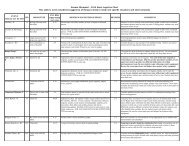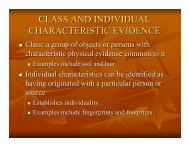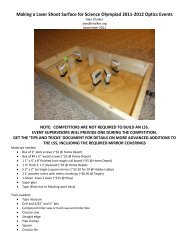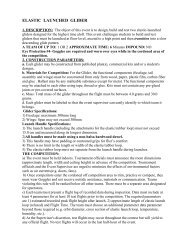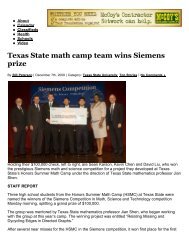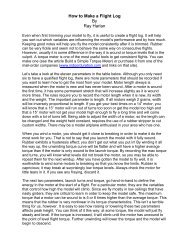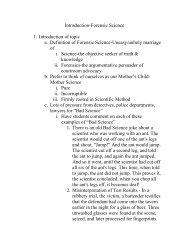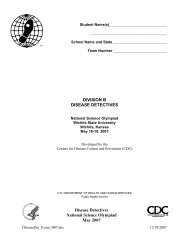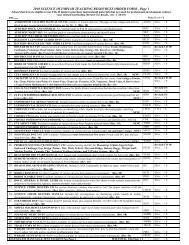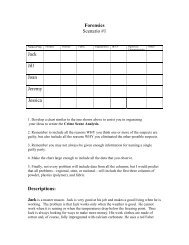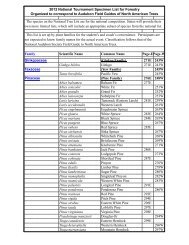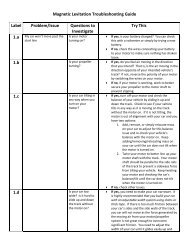Balloon Launched Gliders - Science Olympiad
Balloon Launched Gliders - Science Olympiad
Balloon Launched Gliders - Science Olympiad
You also want an ePaper? Increase the reach of your titles
YUMPU automatically turns print PDFs into web optimized ePapers that Google loves.
Trial/Pilot Event<br />
Contact the organizers of your tournament to find out what trial/pilot events will be held.<br />
BALLOON LAUNCH GLIDER<br />
1. DESCRIPTION: Teams will construct and fly monoplane gliders that will be launched from a balloon to achieve a maximum<br />
flight time.<br />
A TEAM OF UP TO: 2 IMPOUND: No TIME: 8 minutes<br />
2. CONSTRUCTION: Prior to the tournament, participants may construct and test up to two gliders that may be constructed<br />
from published plan(s), commercial kits and/or a student’s design. All gliders must meet the following specifications:<br />
a. <strong>Gliders</strong> must be constructed only from wood, foam, paper, plastic film covering and glue. The major components (e.g., wing<br />
assembly, tail assembly<br />
Trial/Pilot<br />
or fuselage) may be attached together using thread, music wire, malleable wire, paper or plastic<br />
tubes, and/or rubber bands. Kits may be used however; they may not contain any pre-glued joints or pre-covered surfaces.<br />
b. Any dense material may be used for ballast.<br />
c. Total mass of the glider must be at least 2.0 grams throughout the flight.<br />
d. The glider must be a monoplane (one wing) not exceeding a maximum horizontally projected wing span of 48.0 cm, a<br />
maximum wing chord (straight line distance from leading edge of wing to trailing edge, parallel to the fuselage) of 10.0 cm, a<br />
maximum horizontally projected stabilizer<br />
Event<br />
span of 28.0 cm, and a maximum stabilizer chord of 9.0 cm.<br />
e. Each glider must be labeled in such a way as to be easily identified by the event supervisor. At least one vertical surface<br />
on the glider (such as a fin) must be covered in an opaque, non-white material so it can be identified at the top of its<br />
flight.<br />
3. THE COMPETITION:<br />
a. The event must be held indoors. The room dimensions (approximate length, width and ceiling height) should be made<br />
available to teams in advance of the competition. Directors and supervisors are urged to minimize the effects of<br />
environmental factors such as air currents (e.g., doors, fans).<br />
b. Only contestants and judges will be allowed in the event area while teams are competing. Once teams enter the event<br />
area to compete, they may not leave the area or receive outside assistance, materials or communication<br />
until they are finished competing. Teams violating this rule will be disqualified. A separate area shall be provided for<br />
spectators.<br />
c. Each team should present a flight data log at check-in. To be complete the log must contain a minimum of 4 parameters<br />
recorded for each of ten or more test flights flown prior to the competition. The minimum parameters recorded must be:<br />
i. Approximate height of balloon at glider launch<br />
ii. Glider mass at launch<br />
iii. Flight time<br />
iv. Any other parameter selected by the team. The same parameter must be recorded for each flight.<br />
d. At the Regional level only: The Event Supervisor will provide one helium inflated Mylar balloon (30-40” when preinflated)<br />
turned on its side without a platform-launching device/perch attached, so that a glider can balance on top.<br />
i. A light line (e.g., fishing line) more than long enough to reach the ceiling of the site will be attached to the base of the<br />
balloon. It is recommended that the line be attached to a fishing reel for rapid recovery and to prevent tangles.<br />
ii. The balloon provided by the event supervisor will not be available for practice flights. Teams may not modify the balloon<br />
provided by the event supervisor.<br />
e. At the State and National level: Teams must provide their own <strong>Balloon</strong> Launching Rig (inflated balloon, line(s) and<br />
launching perch such as pleated paper or balsa platform).<br />
<strong>Balloon</strong><strong>Launched</strong>Glider.doc 5/30/2008<br />
Copyright © 2008, <strong>Science</strong> <strong>Olympiad</strong> Inc - All Rights Reserved
Trial/Pilot Event<br />
Contact the organizers of your tournament to find out what trial/pilot events will be held.<br />
f. Teams may bring and use their own <strong>Balloon</strong> Launching Rig and helium during practice and official flights at any<br />
competition.<br />
g. Helium will not be provided at any competition.<br />
h. Judges may limit the number and location of balloons at any given time during the event.<br />
i. At the Event Supervisor’s discretion, practice flights may occur throughout the event but will yield to any official flight.<br />
Multiple practice flights may occur at the same time. No practice flights will be permitted in the last half-hour of the event.<br />
j. A self-check inspection station may be made available to competitors for checking their gliders prior to being checked by the<br />
judges.<br />
Trial/Pilot<br />
k. Students will check-in with their event materials (gliders(s) and log) for inspection immediately preceding their<br />
official flights.<br />
l. Teams may make up to a total of 3 official flights using one or two gliders.<br />
m. Teams will be given an 8 minute "Flight Period", starting when their first official flight begins, to launch their official flights.<br />
Any flight beginning within the 8-minute period will be permitted to fly to completion. Participants may make<br />
adjustments/repairs to the gliders between<br />
Event<br />
flights however; time for such adjustments/repairs will be part of the 8-minute<br />
flight period.<br />
n. The judges will measure and record the "Time Aloft" to the nearest tenth of a second for each flight. Time Aloft begins when<br />
the glider leaves the <strong>Balloon</strong> Launching Rig and stops when any part of the glider touches the floor or when the judges<br />
determine the flight has ended.<br />
o. The Event Supervisor may permit other official flights during the flight of another team’s glider.<br />
p. Steering the glider during flight is prohibited. In the unlikely event of a collision with another aircraft, a team may elect a reflight.<br />
The decision to re-fly may be made after the glider lands. The eight-minute period does not apply to such a flight.<br />
q. Resource links may be found at http://www.soinc.org/events/blg/<br />
4. SCORING: The winner is the team with the longest Time Aloft for two flights. The best two flights will<br />
be added together and that will be the overall score. Ties will be broken by the third longest time.<br />
a. Teams with incomplete flight logs will have 10% of the flight time deducted from each flight.<br />
b. Teams without flight logs will have 30% of the flight time deducted from each flight.<br />
c. Teams that violate a rule under "CONSTRUCTION" or "THE COMPETITION" that does not have a specific penalty will be<br />
ranked after all teams that do not violate the rules.<br />
National <strong>Science</strong> Education Standard: Content Standard E: All students should develop abilities of<br />
technological design and understandings about science and technology.<br />
THIS EVENT IS SPONSORED BY THE ACADEMY OF MODEL AERONAUTICS<br />
http://www.modelaircraft.org/<br />
<strong>Balloon</strong><strong>Launched</strong>Glider.doc 5/30/2008<br />
Copyright © 2008, <strong>Science</strong> <strong>Olympiad</strong> Inc - All Rights Reserved



